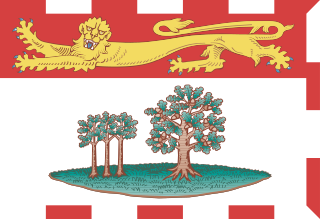
Prince Edward Island is one of the thirteen provinces and territories of Canada. While it is the smallest province in terms of land area and population, it is the most densely populated. The island has several nicknames: "Garden of the Gulf", "Birthplace of Confederation" and "Cradle of Confederation". Its capital and largest city is Charlottetown. It is one of the three Maritime provinces and one of the four Atlantic provinces.

Lot 30 is a township in Queens County, Prince Edward Island, Canada. It is part of Hillsboro Parish. Lot 30 was awarded to John Murray in the 1767 land lottery.

Lot 65 is a township in Queens County, Prince Edward Island, Canada. It is part of Hillsboro Parish. Lot 65 was awarded to Richard Wright and Hugh Owens in the 1767 land lottery. In 1796, then-Lieutenant Governor Edmund Fanning granted Lot 65 to fellow Loyalist Andrew Ladner, with Louisa Augusta Fanning and Peter MacGowan as witnesses. Both Fanning and Ladner were Loyalist immigrants from the newly formed United States. Andrew Lander died in 1836 and is buried on the lot, in the location now known as Nine Mile Creek.

Lot 34 is a township in Queens County, Prince Edward Island, Canada. It is part of Charlotte Parish. Lot 34 was awarded to John Dickson in the 1767 land lottery while Dickson was the Member of Parliament (MP) for Peeblesshire. Sir James Montgomery, 1st Baronet obtained the land upon Dickson's death. As of the 2006 census, there were 2,355 people living on a land area of 92.12 square kilometres (35.57 sq mi).

Lot 35 is a township in Queens County, Prince Edward Island, Canada. It is part of Bedford Parish. Lot 35 was awarded to Sir Alexander Maitland, 1st Baronet in the 1767 land lottery. It was sold in 1792 to John MacDonald of Glenaladale.

Lot 50 is a township in Queens County, Prince Edward Island, Canada. It is part of St. John's Parish. Lot 50 was awarded to Henry Gladwin and Captain Peter Innes in the 1767 land lottery. One quarter of the lot was granted to Loyalists in 1783.
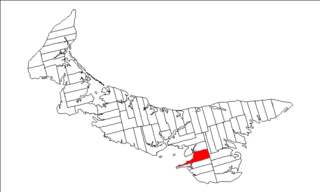
Lot 57 is a township in Queens County, Prince Edward Island, Canada. It is part of St. John's Parish. Lot 57 was awarded to merchant Samuel Smith and Captain James Smith in the 1767 land lottery. By 1803, it had been sold to the Thomas Douglas, 5th Earl of Selkirk.
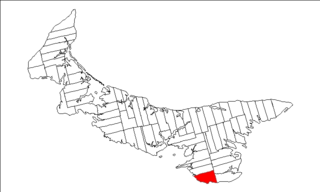
Lot 62 is a township in Queens County, Prince Edward Island, part of St. John's Parish. Lot 62 was awarded to Richard Spry, Esquire in the 1767 Land Lottery, and came to be settled through the efforts of Thomas Douglas, The 5th Earl of Selkirk in 1803. Richard Spry, Esquire, was then Commodore, Commander-in-Chief, Mediterranean Fleet at Gibraltar 1766–1769. Becoming the proprietor, he would be familiar with then the Island of St. John, having first come out to North America in 1754, with the English naval blockade of Ile Royal and the Fortress of Louisbourg in 1756, and then serving off Quebec and in the St. Lawrence into 1759. In 1762, he returned as Commander-in-Chief, North America, quartered in Halifax.
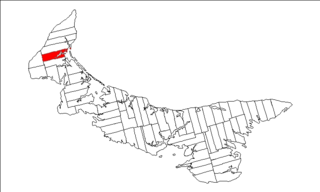
Lot 5 is a township in Prince County, Prince Edward Island, Canada created during the 1764–1766 survey of Samuel Holland. It is part of Egmont Parish.

Lot 8 is a township in Prince County, Prince Edward Island, Canada. It is part of Halifax Parish. Lot 8 was awarded to Arnold Nisbett (M.P.) in the 1767 land lottery, passed to William Kilpatrick and Benjamin Todd in 1775, and to Todd's heirs in 1783.
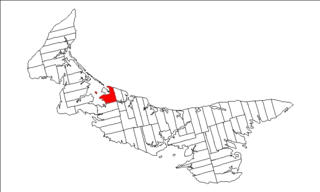
Lot 18 is a township in Prince County, Prince Edward Island, Canada. It is part of St. David's Parish. Lot 18 was awarded to John Stewart and William Allanby in the 1767 land lottery.

Lot 40 is a township in Kings County, Prince Edward Island, Canada. It is part of St. Patrick's Parish. Lot 40 was awarded to Lieutenant George Burns and merchants George Spence and John Mills in the 1767 land lottery.
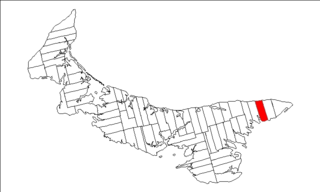
Lot 45 is a township in Kings County, Prince Edward Island, Canada. It is part of East Parish. Lot 45 was awarded to William Matthew Burt MP and John Callender in the 1767 land lottery.

Lot 51 is a township in Kings County, Prince Edward Island, Canada. It is part of St. George's Parish. Lot 51 was awarded to John Pringle in the 1767 land lottery.
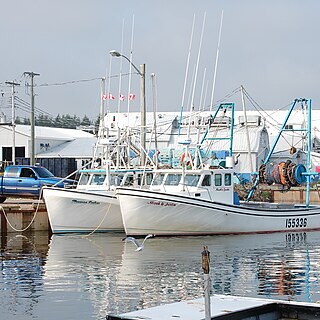
Murray Harbour is a community that holds rural municipality status in Prince Edward Island, Canada. It is located in southeastern Kings County.

The history of Prince Edward Island covers several historical periods, from the pre-Columbian era to the present day. Prior to the arrival of Europeans, the island formed a part of Mi'kma'ki, the lands of the Mi'kmaq people. The island was first explored by Europeans in the 16th century. The French later laid claim over the entire Maritimes region, including Prince Edward Island in 1604. However, the French did not attempt to settle the island until 1720, with the establishment of the colony of Île Saint-Jean. After peninsular Acadia was captured by the British in 1710, an influx of Acadian migrants moved to areas still under French control, including Île Saint-Jean.
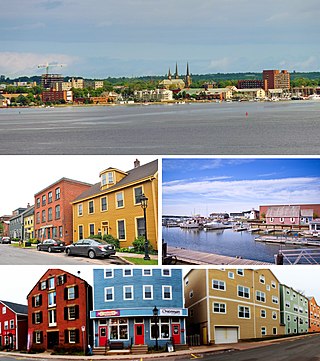
Charlottetown is the capital and largest city of the Canadian province of Prince Edward Island, and the county seat of Queens County. Named after Queen Charlotte, Charlottetown was an unincorporated town until it was incorporated as a city in 1855.
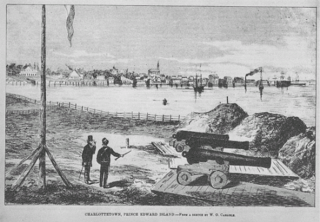
The History of Charlottetown can be traced back to the original French military settlement established on the site in 1720. Over the years Charlottetown has grown to become the largest and most important city on Prince Edward Island.

The Land Question, as it pertains to the history of Prince Edward Island, now in Canada, related to the question of the system of ownership of land on the island. Proprietors, the owners of the land parcels on Prince Edward Island, favoured a system of renting to tenants, but the tenants preferred a system of freehold. In 1767, the British government divided all land in Prince Edward Island into lots to be owned by proprietors, who would collect rent from the settlers, or tenants. Problems soon arose with this scheme, and the low numbers of tenants resulted in proprietors collecting little rent, which in turn led to many proprietors defaulting on their quitrents. An attempt at compulsorily acquiring the land by the Prince Edward Island government from rent defaulters in 1781 resulted in Colonial Office intervention in 1783. In 1786, Governor Walter Patterson, who had set in motion the compulsory acquisition, was removed from office.
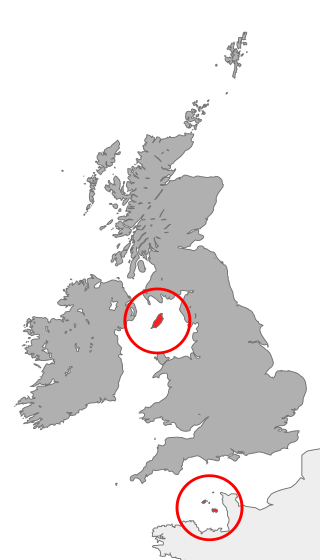
A number of places in the world, like the places named after places in other parts of Britain, were named after the Channel Islands, or some place therein. Not all are named directly for one of the islands, but are often named indirectly, such as for another place on the list.




















